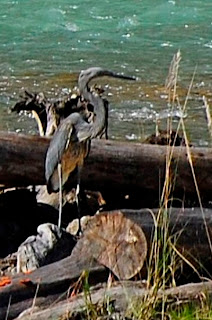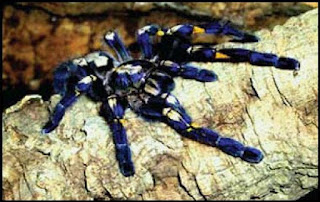Short URL to the story: http://goo.gl/1mwHv
However, the report does not actually detail on the way or the criterion with which the 100 most threatened species were selected. There is wide spread criticism that many of the important species were left out in the list.
According to the list of 100 most threatened organisms in
the world prepared by more than 8,000 scientists from the IUCN Species Survival
Commission and released at the ongoing World Conservation Congress at Jeju in
South Korea, four organisms found in India belong to the category.
 |
| White bellied heron (Ardea insignis) Image Courtesy: Mahesh Iyer (Wikimedia Commons) |
Great Indian Bustard (Ardeotis nigriceps), White
bellied heron (Ardea insignis), Common batagur or Four-toed terrapin (Batagur
baska) and Gooty tarantula(Poecilotheria
metallica) which are found in different parts of India are among the most
threatened organisms in the world, says the report which is named “Priceless or Worthless?”. All of them are already listed as Critically Endangered in IUCN Red List
White Bellied Heron
has only 70 to 400 individuals remaining in Bhutan, Myanmar and North East
India, says the report. Accoridng to it, habitat destruction from hydroelectric
projects has brought down the number of individuals. Captive breeding and release
and avoiding adverse use of riverine habitat are suggested as urgent action
required for saving the species.
 |
| Great Indian Bustard (Ardeotis nigriceps) Image Courtesy: LRBurdak (Wikimedia Commons) |
Great Indian Bustard
has only 50 to 249 mature individuals remaining. The bird which is found only
India is threatened by “Habitat loss and modification due to agricultural
development”, says the report. While establishment of protected areas and
community reserves is suggested as the action required, the report interestingly suggest realignment of Indira
Ghandi Nahar Canal project for saving the bird.
Distributed in Bangladesh,
Cambodia, India, Indonesia and Malaysia, Common batagur or four toed terrapin
is threatened by illegal export from Indonesia to China. India may be the best place
to conserve the animal, if the illegal trade is cubed in the region, as
suggested by the report. “Enforcement of CITES Appendix I restrictions and
control of illegal trade” is listed as the urgent action required to save the species.
 |
| Common batagur or Four-toed terrapin (Batagur baska) |
Gootyy Tarantula,
reported so far only from Andhra Pradesh in India, is also threatened by
habitat loss and illegal trade, as per the report. The report suggests awareness programs and a curb
on illegal trade as protection measures apart from habitat protection,
community awareness.
Current Conservation status in India
Despite the heightened
conservation significance as an endemic spider,
Gootty Tarantula is yet to be included in the schedule I of Wild Life (Protection) Act of 1972, which is the major law to conserve rare organisms in India.
 |
| Gooty Tarantula (
Poecilotheria metallica) Image Courtesy: ZSI |
The report
has suggested the same among the urgent action required to protect Gootty
Tarantula.
Four Toed Terrapin, Great Indian Bustard and White bellied Heron are already included in Schedule I of the act.
Authorities have been mulling over announcing Critical Bustard Areas in India
to the save the bird recently, as suggested by the report.
Apart from the four,
Amsterdam albatross (Diomedea amsterdamensis) which is often found in the
Indian Ocean is also listed among the 100 most threatened organisms in the world.

No comments:
Post a Comment
Please feel free to have your say on our stories. Comments will be moderated. anonymous Comments will not be approved. No links in the comment body unless meant for sharing a very relevant info.